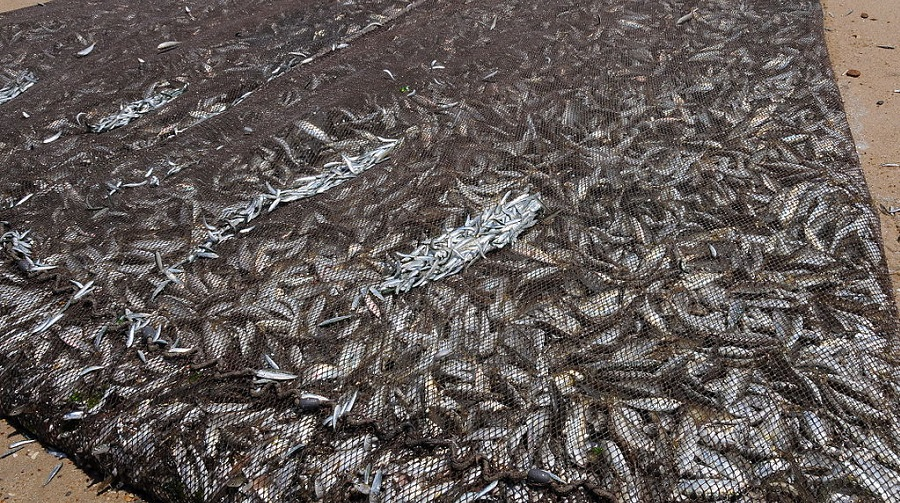
Fish net in Mira, Portugal. Reference photo by Joseolgon, Wikimedia Commons.
In fisheries management, Maximum Sustainable Yield or MSY refers to the theoretical highest catch that a fish stock can support in the long-term, given that environmental conditions do not change much.
Almost 70 years ago, US fisheries scientist M.B. Schaefer proposed that catches up to MSY could be obtained and maintained if fisheries managers made sure that the fishers left in the water a biomass equivalent to at least 50 per cent of the unexploited fish population, that is, of its initial biomass. This unexploited biomass, or ‘carrying capacity,’ represents the population size which the ecosystem would normally accommodate.
With time, however, Schaefer’s model started to be reinterpreted by fisheries scientists and managers such that, for many fish populations, a biomass lower – sometimes considerably lower – than half of the carrying capacity was deemed sufficient to generate what they still called ‘MSY.’ Thus, in terms of the original Schaefer model, they promoted overfishing.
In a paper published in the ICES Journal of Marine Science, Daniel Pauly, the principal investigator of the Sea Around Us initiative at the University of British Columbia’s Institute for the Oceans and Fisheries, and Rainer Froese, a senior scientist at the GEOMAR Helmholtz Centre for Ocean Research, propose to bring the MSY concept back to its origins, without adding ‘tricks’ to it that would lead to excessive fishing under the disguise of sustainability.
Why is it important to go back to the original MSY concept?
Pauly: One of the reasons is because, these days, many people are interested in consuming ‘sustainable fish.’ Consumers tend to believe that when their grocery shop offers them a fish with such a label, it means that it was removed from a healthy, well-managed stock. However, if the agency or country managing that stock allowed it to decline below half its unexploited abundance, this stock is overfished, whatever the claims of ‘sustainability’ are.
Froese: Earlier – like many other scientists – we used to believe that the MSY concept was outdated and stood in the way of proper ecosystem-based fisheries management because this concept focuses on one species at a time. However, we started using a new implementation with hundreds of stocks globally and it worked perfectly well because, at stock sizes above 50% of unexploited biomass, most fish can still fulfil their natural roles as prey or predator. We now believe that the MSY concept, if applied correctly, can be more useful to ecosystem-based fisheries management than other, data-hungry assessment methods.
How has the MSY model been abused?
Pauly: Since the early seventies, some fisheries practitioners have been modifying Schaefer’s model to a point that has led fisheries management agencies in several major countries to assume that MSY occurs when a stock’s size has been reduced to 40 or even 30 per cent of its unfished biomass. Yet, they let us believe that they rely on a model which is explicitly structured around ecological considerations implying that when a stock’s biomass is reduced below 50 per cent of carrying capacity, it is overfished.
This situation is aggravated by the fact that the official stock assessments that produced these low MSY estimates are also based on truncated time-series, which omits catches from earlier period of high abundance.
Froese: Another form of abuse of the MSY concept occurs when it is applied to an ensemble of discrete populations. One case that we refer to in the paper uses a combined MSY for numerous seamount-specific populations of orange roughy. This doesn’t make sense because the declining biomass of one population does not affect the density and population growth of the other, and this misuse of MSY led to the collapse of numerous stocks of orange roughy.
What is the right way of applying the MSY model?
Pauly: In principle, most fisheries scientists and legislations agree that MSY should be a limit, and not a target for fisheries management because if it were a target, this target would be exceeded about half of the time just because of uncertainties in estimation and application, resulting in overfishing and stock decline. This implies that target catches should be set below and target biomass above the MSY level.
Also, at biomass levels of, for example, 60 per cent or more of carrying capacity, populations are much more capable of fulfilling their ecological roles than at the currently common 30–40 per cent levels, while at the same time supporting good catches.
Froese: Smart fisheries management, such as applied in Australia, aims for biomass 20 per cent higher than that needed to generate MSY. This allows them to maximize the economic benefits from fisheries and to radically reduce the risk of unintentional overfishing.
To schedule interviews with the authors please contact Valentina Ruiz-Leotaud v.ruizleotaud[at]oceans.ubc.ca

